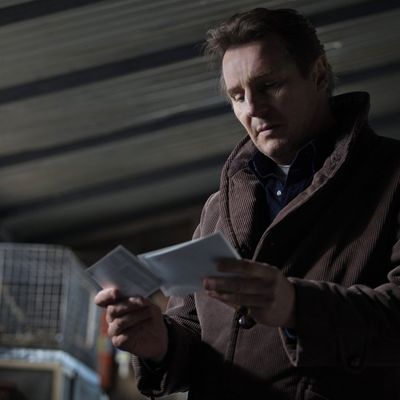
I’ve been reading Lawrence Block’s New York–set Matthew Scudder detective novels for almost three decades and hoping that some filmmaker would finally nail their distinctive, highly influential vibe, in which the PI hero meets sadism with grim stoicism but goes all-out to get the bad guys anyway: If it’s in his control to do something, he will — he must — act. Hal Ashby’s 8 Million Ways to Die missed the essentials (it was set in L.A.!), although it did have its druggy charms. Now the talented writer-director Scott Frank comes awfully close in his adaptation of one of Block’s better novels, A Walk Among the Tombstones. I’d be way more enthusiastic if Frank hadn’t swapped out the book’s horrific, unforgettable ending for something so conventional, I can barely remember it a few days later.
The bad guys (David Harbour and Adam David Thompson) introduced at the outset are very bad, indeed. They’re grinning kidnappers of women who take the ransom and then return their victims, as agreed — only lovingly cut into small pieces. An unlicensed PI who lives in a bare, cheerless apartment, Scudder (Liam Neeson) doesn’t want the job of hunting them down when he realizes that the latest victim’s husband (Dan Stevens, of Downton Abbey) made his money as a drug kingpin. But when he understands the depth of the murderers’ depravity — and the inevitability that they’ll kill again and again — he knows he has no choice. He’s a trudger. He interviews witnesses, finds evidence of other victims, and wanders a gray, malignant city in mourning over something he did years ago while drunk. He’s another of God’s Loneliest Men.
The thing to remember about Block and Scudder is that alcohol — and Alcoholics Anonymous — are central. Block has talked openly about his decades-long attendance, and Scudder is always taking breaks from detective work to pop into meetings. (He also tithes a percentage of his fees to various churches.) Though it’s never specifically cited, the “Serenity Prayer” — “God, grant me the serenity to accept the things I cannot change, the courage to change the things I can, and the wisdom to know the difference” — is a controlling force. Scudder isn’t a reckless vigilante eaten up with rage. He has the wisdom to know what can’t be changed and what can. He’s centered — sometimes to the point of being a little dull. What saves him is that he doesn’t preach. He likes sitting in bars drinking coffee alongside unsavory characters. He’s fascinated by people who don’t have control. (Wong Kar-wai was generally taken as the auteur behind the barroom drama My Blueberry Nights, but Block co-wrote the screenplay, and the film had as much to do with his worldview.)
Scudder, then, is much different from Neeson’s other bad-guy-hunter, Bryan Mills, in the Taken movies. He’s slower and heavier-spirited. Neeson gives him the requisite weight along with that Hibernian sadness he carries in most of his roles. He looks terrific in his heavy coat with the collar turned up as he walks around Green-Wood Cemetery, where pieces of a body turned up — it’s as if his whole life is lived among tombstones. For some reason, Neeson and Frank have decided to give Scudder a New Yawk accent, though that hurts less than it might since it’s always slipping. Never have I been so grateful for an absent dialect coach.
It’s clear from the sunless palette and the measured, one-thing-after-another pacing that Frank loves Block’s work, and that goes a long way. The performances go a long way, too. Stevens evokes every shade of the self-made drug kingpin’s thoughts: His hands are tied, but he visibly hungers to wrap them around the killers’ necks. Boyd Holbrook is eloquently jittery as his addict brother, Olafur Darri Olafsson has two vivid scenes as a graveyard attendant, and what can you say about David Harbour’s tauntingly demonic Ray? You’d cross the street in life if you saw him coming. (He’s equally effective in the coming The Equalizer.) Frank’s biggest challenge was introducing a Block regular — a wayward black teen named TJ (Brian “Astro” Bradley) who talks himself into Scudder’s life — without making the relationship seem too sentimental. He only half-succeeds — it is sentimental — but it helps that Bradley has a hard, unbeatific face, and that the movie needs his bopping energy.
And there I would leave it if not for that botched climax.
Was the original shot and discarded? What’s there now is not just different from the novel, it also features a recitation — woven through the action — of all 12 AA steps, which just seems weird. But I could have lived with that. What I can’t accept is the loss of the finale that gives A Walk Among the Tombstones its grisly poetic symmetry and conclusively demonstrates the difference between Scudder’s passive acceptance of violence and the vigilante fury of the man he’s working for. It’s true that the book’s ending would have been hard to bring off. For one thing, Scudder plays only a peripheral role — an action-movie no-no. For another, it would give The Human Centipede a run for its money. But the way the movie stands, it’s as if a vital body part has been lopped off. Which is ironic if you know what I’m talking about.


